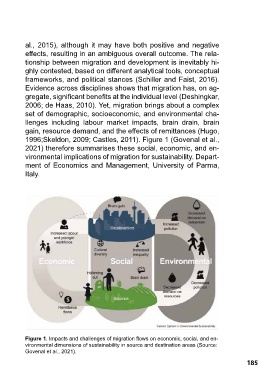Page 185 - UNAM-GCUB2022
P. 185
al., 2015), although it may have both positive and negative
effects, resulting in an ambiguous overall outcome. The rela-
tionship between migration and development is inevitably hi-
ghly contested, based on different analytical tools, conceptual
frameworks, and political stances (Schiller and Faist, 2016).
Evidence across disciplines shows that migration has, on ag-
gregate, significant benefits at the individual level (Deshingkar,
2006; de Haas, 2010). Yet, migration brings about a complex
set of demographic, socioeconomic, and environmental cha-
llenges including labour market impacts, brain drain, brain
gain, resource demand, and the effects of remittances (Hugo,
1996;Skeldon, 2009; Castles, 2011). Figure 1 (Govenal et al.,
2021) therefore summarises these social, economic, and en-
vironmental implications of migration for sustainability. Depart-
ment of Economics and Management, University of Parma,
Italy.
Figure 1. Impacts and challenges of migration flows on economic, social, and en-
vironmental dimensions of sustainability in source and destination areas (Source:
Govenal et al., 2021).
185

